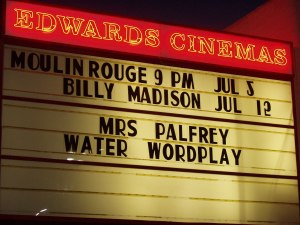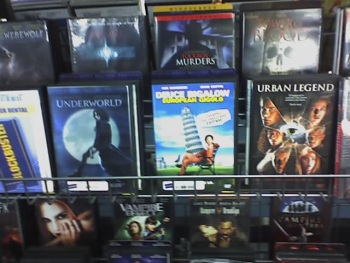Notice anything odd about this Flashback Features movie marquee? (Hint: Look at the dates.)

I think I can see a solution to their problem…
Notice anything odd about this Flashback Features movie marquee? (Hint: Look at the dates.)

I think I can see a solution to their problem…
Some interesting comments by Warren Ellis in today’s Bad Signal on film budgets, and Superman Returns in particular.
$250 million puts you in spacelaunch-budget territory. For $250 million WB could’ve given Bryan Singer his own communications satellite and spent the change on a George Clooney movie.
This is the absurdity of modern Hollywood; that taking more than the GNP of Luxembourg in a single weekend is not actually enough to put a movie in the black.
It’s the “spacelaunch” comment that I find most interesting, as I made the same comparison a few years ago, from the other side of the fence: Assuming that the Spirit and Opportunity missions to Mars are typical, price-wise, it doesn’t make sense to complain that we’re “wasting” money on space exploration when a mission costs as much as two summer blockbusters. Manned missions are, of course, more expensive, but robotic missions? If we, as a society, toss away $250 million several times a year on mindless action flicks, what’s so terrible about spending a similar amount to learn something about our universe?
Yes, I know the difference is public vs. private funding. Movies are financed by studios and private investors, and space exploration is usually financed by governments, and therefore by taxes. But comparing the dollar amounts puts things in a different perspective—whether you’re astonished by the literally astronomical movie budgets, or realizing that exploring outer space is more down to Earth than it seems at first glance.
Last night we went to see a screening of Twelve Monkeys, still one of my favorites. There was an odd moment in the middle, though. In the scene in which Bruce Willis and Madeline Stowe are attacked in the abandoned theater, just after Willis’ character kills the attacker, is this exchange:
“You killed him!”
“All I see are dead people.”
Nervous laughter cascaded around the theater as the audience flashed forward to The Sixth Sense and its signature catch-phrase.
I love Netflix. I love their selection. I love being able to just make a list of movies I’ve been meaning to watch, and see them show up one by one. But the queue model doesn’t work so well when you want to watch a specific movie now. That’s where you need a retail store, or download-on-demand.
One of our local movie theaters is running a series of “Flashback Features”, and this coming Wednesday is Young Frankenstein. I thought, given the number of references, if would be fun to watch Son of Frankenstein before we went. No time for Netflix, and Blockbuster didn’t have it, so I decided to try a local video store.
You can find all kinds of things at local stores. Blockbuster might toss something that doesn’t pull in $X/month, or doesn’t fit their market research. Shelf space at a Blockbuster is precious. They stock lots of copies of new releases. They keep their aisles wide. And they store movies face outward, so each title takes up more space. A local video store will cram as many movies as they can onto the shelf, spine-outward, sometimes laid sideways on top of each other, and they can add more shelves until they run up against fire regulations. The space freed up by tossing an underperforming movie is nothing compared to the possibility that someday, someone might rent it. This store had videotapes that were still in the oversized boxes that went out of style in the late 1980s!
The downside, of course, is that they probably won’t have enough staff to keep this larger selection sorted. The S section at this store consisted of at least eight shelving units with four or five shelves each. I found all sorts of movies I’d forgotten about or never even heard of in the first place (there’s a Skulls III? With Glory?). If I’d been looking for a random movie to watch, it would’ve been great, but I was looking for Son of Frankenstein. By the time I gave up looking, I figured there was no point in asking a clerk whether they had it or not. Even if they did, I’d still be stuck searching through 40+ shelves.
Not that Blockbuster gets it right all the time. I noticed an anomaly in the Horror section today:

Although given what I’ve heard about Deuce Bigalow: European Gigolo, perhaps Horror is the right category for it.
In the end, I called up my parents and asked if they had a copy of Son of Frankenstein. It turns out they did, so the whole thing dropped out of the realm of commerce and into the realm of borrowing.
Apparently the movie industry is trying to come up with an ad campaign to get people back into theaters. The LA Times doesn’t seem to take the idea terribly seriously, as they’ve suggested the slogan, “Movies: Just like DVDs, but Larger.” Meanwhile, theaters and studios are blaming each other for the decline in attendance:
Theater owners blamed Hollywood for making inferior (and overly long) movies, studios worried that theaters were turning the multiplex (with its barrage of pre-show commercials) into as much of an ordeal as an escape.
How do you figure out who’s right? Oh, wait, that’s easy: Both of them.
Make better movies, and more people will brave the long lines, high prices, 20 minutes of annoying big-screen commercials, 15 minutes of previews for movies that aren’t terribly interesting, people yakking on cell phones, people narrating the entire @%!# movie for their friends 30 seconds ahead of the action, etc.
Clean up the theater experience, and people will be willing to go for movies that look kinda interesting instead of really interesting.
It’s not just the big screen and immersive sound. Watching Serenity at home lacked the intensity of watching it in a theater full of fans (even the second time, when we knew what to expect). Neither canned laughter nor a studio audience can compare to dozens or hundreds of people laughing together in the same room. And it’s hard to match the collective “Oh, $#!7” that swept the theater in each showing of Return of the King when Shelob showed up again after Frodo thought he had escaped. The communal experience strikes a chord that you just can’t reach with a couple of people and a TV set.
People who talk through the entire movie aren’t just distracting you from the movie, they’re interfering with that communal experience. There’s only so much theater staff can do, short of kicking people out, but at least we know in the future they’ll get to inhabit a special level of Hell. 😈